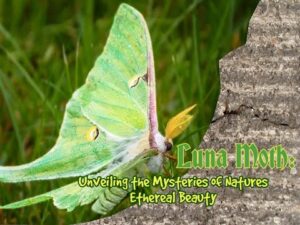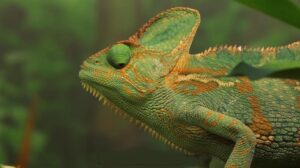Fake plants are generally safe for chameleons if they are free from sharp edges and harmful chemicals. Ensure the plants are thoroughly washed and specifically designed for reptile use.
Chameleons thrive in environments that mimic their natural habitat, which often includes plants that provide them with cover and a semblance of a jungle environment. Pet owners sometimes opt for artificial plants because they require less maintenance and are durable.
But safety remains a priority, and so it’s crucial to select fake plants that pose no risk of injury or toxicity to your chameleon. In this introduction to chameleon-safe habitats, we will explore the use of synthetic foliage, ensuring a secure and stimulating environment for your reptilian companion without sacrificing the practical benefits of faux plants. By choosing the right type of artificial plants, you create a visually appealing setup for observers, and most importantly, a healthy and stress-free home for your pet chameleon.
The Allure Of Fake Plants
Picture a jungle bursting with greenery—a sight that chameleons naturally love. Yet, bringing the jungle vibe into a home or an enclosure isn’t always easy. This is where fake plants come to the rescue. They offer a vibrant, lush look without the hassle of upkeep. But are they safe for your color-changing friends? Let’s explore the magnetic charm of artificial foliage.
Visual Appeal And Maintenance
The aesthetic charm of fake plants is undeniable. They come in endless varieties and stunning colors. Even more, they stay forever young without dropping leaves or fading. Chameleons enjoy the sight of greenery, and these plants deliver that 24/7.
Ease of maintenance is another standout feature. Real plants demand water, the right soil, and proper sunlight. Fake plants swap all that for a simple dusting. They’re always ready, rain or shine, looking their best with minimal effort.
Popularity In Chameleon Habitats
When it comes to chameleon homes, faux plants are stars. Reptile enthusiasts love them. They’re not only safe but also offer climbing paths for chameleons. With no sharp edges, they’re gentle on delicate reptile skin.
- No risk of parasites or pesticides—common issues with live plants.
- Constant greenery, irrespective of seasons or indoor lighting conditions.
- Flexible design options to mimic a chameleon’s natural habitat.
Safety matters most. With fake plants, there’s no worry about toxic plants that can harm your pet. Always ensure the materials are non-toxic and free from sharp edges. Most artificial plants meet these criteria, but it’s wise to double-check.
Natural Habitat Vs. Artificial Decor
Creating an environment that mirrors a chameleon’s natural habitat is crucial for their well-being. But the question remains: are fake plants safe for these colorful reptiles? Understanding what surrounds chameleons in the wild helps in making informed choices between natural and artificial decor. This section delves into this very comparison.
What Chameleons Encounter In The Wild
Chameleons thrive amidst rich biodiversity. Exploring their environment, they find:
- Lush foliage for hiding and seeking shelter
- Vibrant flowers that attract prey like insects
- Diverse plant textures aiding in climbing and gripping
Comparison Of Real And Fake Plants
| Real Plants | Fake Plants |
|---|---|
| Enhance air quality | Zero maintenance |
| Require regular care | Pose no allergy risks |
| Offer natural humidity | Could contain harmful chemicals |
Chameleons come into contact with diverse plants in their native habitat which supports their health. On the other hand, fake plants offer ease and convenience but may come with risks. It’s essential to select non-toxic and chameleon-safe artificial decor, to ensure the occupant’s safety. Weighing the pros and cons of each can help recreate a safe and stimulating environment for these remarkable reptiles.
Concerns With Artificial Foliage
Many chameleon owners consider adding fake plants to their pet’s environment. While these plants may seem convenient, they can pose risks. We will look at some of these concerns, especially related to chemical exposure and physical harm.
Chemical Exposure Risks
Artificial plants may harbor chemicals harmful to chameleons. These creatures are sensitive to their surroundings. It is vital to understand the risks involved.
- Chemical leaching from plastic and dyes can contaminate a chameleon’s habitat.
- Volatile organic compounds (VOCs) often emanate from synthetic materials.
- To ensure safety, opt for plants labeled non-toxic and chameleon-friendly.
Constant vigilance with artificial plants helps keep your chameleon safe from harmful substances.
Physical Harm Potential
Fake plants pose a physical threat to chameleons as well. These animals are climbers and explorers by nature. The structural integrity of artificial foliage is a concern.
- Chameleons might ingest small parts of fake plants, leading to internal blockages.
- Sharp edges of artificial plants can cause cuts or abrasions.
- Securely fasten all fake foliage to prevent falls or collapses.
Choosing the safest environment for your chameleon means scrutinizing the physical safety of artificial plants.
Benefits Of Going Faux
The ‘Benefits of Going Faux’ when it comes to chameleon habitats can be vast and varied. Opting for fake plants in a chameleon enclosure not only enhances the vivarium’s aesthetic but also offers a range of practical advantages. Explore how synthetic foliage can elevate your pet’s environment, minimize upkeep, and keep your chameleon safe and happy.
Ease Of Cleaning
Caring for a chameleon should be gratifying, not grueling. Fake plants require minimal maintenance compared to their living counterparts. They eliminate the need for regular watering, trimming, and soil care. This makes cleaning a breeze—simply wash the faux flora with water and a gentle cleanser, and they’re good as new. Not only does this save time, but it also ensures a tidy environment for your reptile friend.
Risk Of Pest Avoidance
Live plants can harbor unwanted guests like mites and other pests that may harm your chameleon. By incorporating artificial plants, you markedly reduce this risk. Synthetic plants don’t decompose or require soil, preventing the conditions pests thrive in. This leads to a healthier habitat for your pet, free from the stress of pest infestations.
Allergy-friendly Options
Both chameleons and their owners can suffer from allergies due to pollen and other plant-related allergens. Fake plants are hypoallergenic, presenting a safe alternative. They allow everyone to breathe easier, ensuring the enclosure’s environment is comfortable for all. This attention to health is paramount for the well-being of your colorful companion.
When selecting faux flora for your chameleon, look for options that match the natural habitat of these creatures. This nurtures their instinctual behaviors and promotes a sense of security. Secure mounting is crucial to prevent accidents. With so many realistic and safe choices on the market, creating a stress-free, beautiful, and functional habitat is simple and rewarding.
Safety Measures For Fake Plants
Chameleon owners often turn to fake plants for a maintenance-free habitat. Ensuring safety with artificial foliage is crucial. Below are measures to protect chameleons from harm.
Non-toxic Material Choices
Selecting the right material for fake plants helps prevent health issues. Chameleons might nibble on leaves, mistaking them for real. Materials should be chemical-free and pet-safe.
- Check labels for non-toxic certification.
- Choose plants made from silicone or natural rubber.
- Avoid plastics with phthalates or BPA.
Always consult a vet or a reliable source before buying fake plants.
Regular Cleaning Routines
Dust and bacteria can accumulate on fake plants. Regular cleaning keeps your chameleon’s environment safe and hygienic.
- Rinse plants under warm, soapy water.
- Use a soft cloth to wipe each leaf gently.
- Dry thoroughly before returning to the habitat.
A clean habitat is a happy home for your chameleon.
Expert Opinions And Recommendations
Welcome to our expert-driven discussion on whether fake plants are safe for chameleons. This section dives deep into what professionals in the field have to say. We explore veterinary and herpetological wisdom to ensure your pet chameleon thrives. Decisions about their care and habitat setup could shape their well-being significantly.
Veterinarians’ Advice On Chameleon Care
Chameleons are unique reptiles that need a particular environment to stay healthy. Veterinarians emphasize the importance of non-toxic materials in their living spaces. Here’s what they advise:
- Avoid sharp edges that can injure delicate skin.
- Ensure fake plants do not contain small parts chameleons can swallow.
- Select fake plants made of safe, non-toxic plastic or silk.
- Clean fake plants regularly to prevent bacterial growth.
Herpetologists’ Insights On Habitat Setup
Herpetologists, experts on reptiles, stress the importance of a naturalistic habitat for chameleons. Here’s what they recommend:
- Balance fake plants with live ones to replicate natural environments.
- Ensure the habitat includes varied textures and levels for climbing.
- Choose fake plants that provide ample hiding spots for stress relief.
- Use a mix of plant sizes to create a dynamic and engaging space.
Making The Right Choice For Your Chameleon
As the guardian of a vibrant chameleon, providing a safe and stimulating environment is key. Fake plants can contribute to this habitat, but it’s important to choose wisely. Let’s discuss how to select the best artificial foliage for your pet’s wellbeing.
Considering Your Chameleon’s Needs
Chameleons need more than just visually appealing surroundings. They require habitats that mimic their natural environment. The selection of plants, whether real or fake, should adhere to these essentials:
- Non-toxic materials: Only non-toxic, chameleon-safe materials should be in the enclosure.
- Appropriate size and shape: Plants must be of suitable size for climbing and exploring.
- No sharp edges: To prevent injury, surfaces should be smooth.
Balancing Aesthetics With Safety
While fake plants can offer consistent color and low maintenance, safety should never be compromised. Always prioritize your chameleon’s health over decorative preferences. Use this checklist to ensure a safe and beautiful habitat:
| Feature | Detail |
| Material Safety | Check for pet-friendly, non-toxic components |
| Easy Cleaning | Select plants that can be easily sanitized |
| Durability | Ensure the plants can withstand chameleon activity |
Through cautious selection and regular habitat assessments, your chameleon can thrive alongside artificial plants that safely enhance their home.
Frequently Asked Questions Of Are Fake Plants Safe For Chameleons?
Will Chameleons Eat Fake Plants?
Chameleons do not eat fake plants; they require live prey or fresh vegetation for their diet.
Do Chameleons Need Real Plants In Their Cage?
Chameleons benefit from having real plants in their cages, as they provide naturalistic habitats and improve air quality.
What Plants Are Not Safe For Chameleons?
Some plants that are unsafe for chameleons include Azaleas, Poinsettias, Oleander, Ivy, and Dumb Cane. Avoid these to ensure a safe environment for your pet chameleon.
Are Fake Plants Non-toxic?
Most fake plants are non-toxic, making them safe for homes and offices. However, it’s best to check product details for specific material information.
Conclusion
To sum up, fake plants offer a risk-free decor option for your chameleon’s habitat. They ensure a vibrant look without the upkeep real plants require. For chameleon owners, this makes them a practical choice. Always select high-quality, non-toxic varieties to keep your pet safe and content.
Embrace the simplicity and peace of mind that come with artificial greenery in your chameleon’s space.

